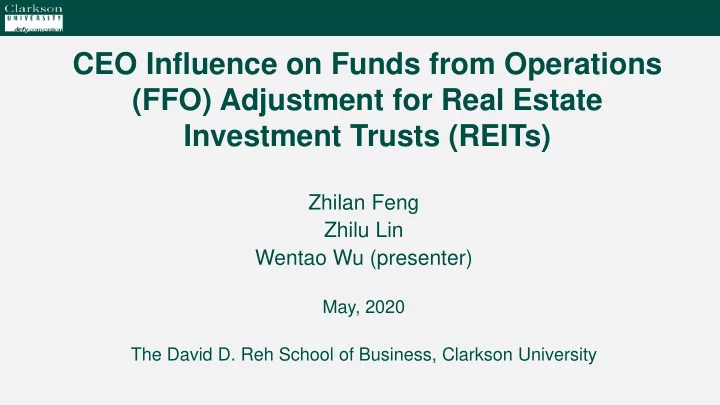

CEO Influence on Funds from Operations (FFO) Adjustment for Real Estate Investment Trusts (REITs) Zhilan Feng Zhilu Lin Wentao Wu (presenter) May, 2020 The David D. Reh School of Business, Clarkson University
Background • The REIT industry has experienced tremendous growth and expansion in recent years. REITs play a important role as an alternative investment vehicle in the portfolios of both individual and institutional investors. • Funds from Operations (FFO) is a widely adopted voluntary disclosure performance measure along with Net Income (NI) by the U.S. REIT industry. • NAREIT believes real estate values are generally not correlated with the GAAP treatment of assets. Hence, it pioneered FFO in the early 90s to provide a better measure of REIT’s operating performance, as market conditions, interest rates, and other macroeconomic factors would affect the valuation as they age.
Background (cont.) ▪ Calculation : FFO is calculated as Net Income (NI, calculated in accordance with the GAAP), ▪ Excluding : 1) Depreciation and amortization related to real estate; 2) Gains and losses from sales of certain real estate assets; 3) Gains and Losses from the change in control; 4) Impairment write-downs of certain real estate assets and investments in entities when the impairment is directly attributable to decreases in the value of depreciable real estate held by the entity.
Background (cont.) ▪ Example, Simon Property Group reported FFO on its 2017 income statement of $4 billion, up 6% from 2016. The firm's net income, meanwhile, totaled $2.2 billion. To arrive at FFO, the firm added back depreciation and amortization of about $1.8 billion, and further adjusted for other smaller figures — including a reduction of $5.3 million for payment of preferred distributions and dividends, and a non-controlling interest portion of depreciation and amortization that resulted in an additional $17.1 million reduction. Simon additionally reported a diluted FFO-per-share figure of $11.21, compared to a diluted EPS figure of $6.24.
Literature and arguments ▪ There are two sides of argument for FFO metric. On the one hand, FFO metric provides superior information over the NI for REITs (e.g., better align with dividend payout policy, provide incremental information, closely associated with stock returns, and assess future cash flows and firm value). ▪ On the other hand, managers use FFO metric to report “better” financial results opportunistically and mislead investors (e.g., reduce the comparability of their earnings figures, and failure to follow accounting standards is likely to lead to inefficient outcomes).
Research questions and testing hypotheses ▪ H1 : If FFO contains additional information, then it should have a stronger association with REIT market-adjusted stock returns, compared to NI. ▪ H2 : FFO adjustment is negatively correlated with concurrent NI if it is a widespread practice in the REIT industry that managers use the FFO adjustment to hide subpar operating performance. ▪ H3 : FFO adjustment is positively associated with CEO tenure (and CEO duality). ▪ H4a : The positive correlations between FFO and REIT market-adjusted stock returns are more significant after clarifications of FFO definition by NAREIT and increased scrutiny by SEC. ▪ H4b : The negative correlation between FFO adjustment and NI, and CEO influence on FFO adjustment are less significant after clarifications of FFO definition by NAREIT and increased scrutiny by SEC.
Main findings ▪ Using the U.S. Equity REIT data from 1993 to 2018, both NI and FFO are associated with REIT stock returns, suggesting both matrix contain information that is valuable to investors. ▪ A significant and positive relationship between FFO adjustment and NI, indicating a possible “selective” and “intentional” inclusion and/or omission of the “good” vs. “bad” news in the FFO reporting. ▪ More powerful CEOs are indeed associated with higher FFO adjustments, suggesting CEOs’ involvement in hiding subpar performance. ▪ A diminished “manipulation” for the majority of the REITs, suggesting these guidelines and scrutiny from NAREIT and SEC have achieved the intended purposes.
Empirical results
Empirical results (cont.) ▪ Table 2 Mean difference
Empirical results (cont.) ▪ Table 4 FFO, ROA and Stock return
Empirical results (cont.) ▪ Table 5 FFO, ROA and Stock return
Empirical results (cont.) ▪ Table 6 FFO adjustment and Change in NI-based ROA
Empirical results (cont.) ▪ Table 7 FFO adjustment and Change in NI-based ROA after 2003
Empirical results (cont.) ▪ Table 8 FFO adjustment and Change in NI-based ROA – Heckman model
Empirical results (cont.) ▪ Table 9 FFO adjustment and CEO power
Empirical results (cont.)
Empirical results (cont.) ▪ Table 10 FFO adjustment and Change in NI-based ROA after 2005
Empirical results (cont.)
Conclusion and discussions ▪ Using the U.S. Equity REIT data from 1993 to 2018, both NI and FFO are associated with REIT stock returns, suggesting both matrix contain information that is valuable to investors. ▪ A significant and positive relationship between FFO adjustment and NI, indicating a possible “selective” and “intentional” inclusion and/or omission of the “good” vs. “bad” news in the FFO reporting. ▪ More powerful CEOs are indeed associated with higher FFO adjustments, suggesting CEOs’ involvement in hiding subpar performance. ▪ A diminished “manipulation” for the majority of the REITs, suggesting these guidelines and scrutiny from NAREIT and SEC have achieved the intended purposes.
Questions?
Recommend
More recommend